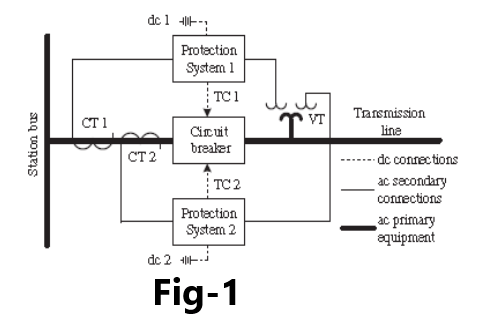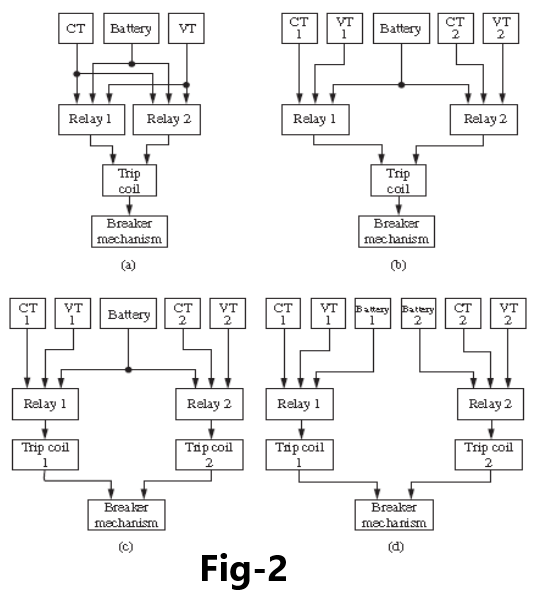
Consider the relay connections in Figure-1, which might be considered the maximum practical redundancy in relay connections. Note that there are two independent relay systems, each of which could contain several relays to detect phase and ground faults on the protected line section.
This system is made very reliable by the use of completely independent systems for
dc power supply (batteries)
secondary potential supply to each relay system
current monitoring for each relay system
dual trip coils in the circuit breaker
Dual communications systems to the remote end of the line can also be provided. In most cases for high voltage systems, the two systems are functionally equivalent protection systems typically named “Protection System 1” and “Protection System 2,” or “System A” and “System B.” In other cases, particularly for lower voltage systems, one system may not have all the selectivity, speed, or sensitivity of the other. In those cases, the systems will be named the “primary” and the “backup” systems.
The redundancy in Figure-1 is not uncommon, except for the redundant battery, which may only be specified at critical locations. Note that all system functions are duplicated except the primary of the voltage transformer and the circuit breaker. The primary of the voltage transformer is normally regarded as sufficiently reliable or available so that redundancy is not required. The independent secondary windings of the voltage transformer are separately protected so that a short circuit on one secondary does not affect the other. As far as the circuit breakers are concerned, it would be possible to place redundant circuit breakers in series and have them controlled by independent relays. This would be very costly and would probably not even be considered except for a circuit that is considered very important for some reason.

Figure-2 shows control configurations that are commonly used in power system protection.
Part (a) has redundancy only in the relays and the two relay systems share the same battery and the same instrument transformers.
In part (b), the system is made more reliable by duplicating the instrument transformers, giving each relay its own independent supply. This leaves the circuit breaker trip coil and breaker mechanism to be the most vulnerable to failure of the protective system.
Part (c) of Figure-2 uses duplicate trip coils and has each relay connected to its own trip coil. Since the added trip coil can be obtained at quite a reasonable cost, this is often considered to be prudent, especially for the higher voltage circuits that carry large amounts of power. On these circuits, failure to properly clear a fault can have very high cost and hence greater redundancy is readily justified.
Part (d) of Figure-2 uses redundancy in all subsystems except the circuit breaker mechanism, which would be very expensive to duplicate. This arrangement would be used at stations where high reliability is very important. Obviously, other control configurations can be devised. It is not likely that a utility would use the same configuration for all applications, since the protected circuits are not equally important to the integrity of the entire system. Generally, the high-voltage bulk power transmission lines will be protected by highly redundant protective systems, since these lines carry large amounts of power and high availability is essential.

It is in reality a nice and helpful piece of information. I am glad that you simply shared this helpful information with us. Please stay us up to date like this. Thank you for sharing.
Thanks for Appreciation, Please share my website to your social group